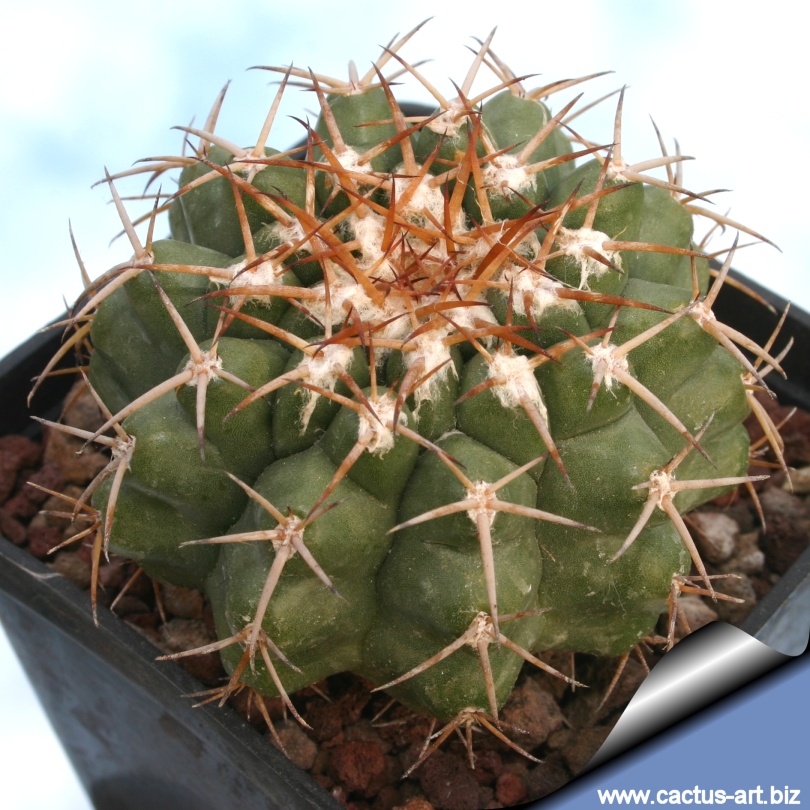|
|

Discocactus eptacanthus
The name eptacanthus means "with seven spines" but
the actual number of spines varies from 5 to 11 depending on origin and
size of the plant.
|
|
Description: D. eptacanthus
is a very variable species which received several different
controversial names, many of them are still used in the trade. It is a
solitary flattened cactus that form a
cephalium at maturity. Some authors consider it a complex of several
species and subspecies.
Stem: Globose or slightly depressed, light green to grey-green,
8-28 cm in diameter, 4,5-15 cm tall (without cephalium)
Ribs: 10-22, up to 2m high, broken up into large, rounded
tubercles, with more or less deep furrows between, sometime spiralling.
Areoles: Round or oval, at first tomentose, approx 6-10 per rib
(in plants with cephalium).
Cephalium: Small, 3-4 cm tall woolly, white to dull pastel with
brow or black erected bristles 3-5 cm long.
Spines: Whitish, yellowish or brown becoming grey with age, more
or less translucent, needle-like or flattened (sometime with vertical
flowers in summer l grooves)
Radial spines: Typically 7, but variable in number from 5 to 11,
up to 1,5 cm long (or more), stout, very rough and slightly recurved.
Central spines: occasionally a central spine
Fruit: Usually white or pale pink.
Flowers: Nocturnal, fragrant, white (or pale pink), funnel form,
nocturnal, 5-7.5 cm long and 5 cm in diameter.
Blooming season: Flowers come in profusion in summer, out of the
cephalium.
|
|
Cultivation: Collectors
consider this cactus genus from South America to be rarities as they are
not the easiest plant to keep happy. it is rather difficult to grow and
frost tender, should be kept at above 15° C if grown on its own roots
(8°C if grafted) need full sun or afternoon shade. Young seedlings are
generally grafted because they are slow growing and very rot prone when
kept on their own roots and though they can’t endure long stretches of
total dryness, too much water will rot them, as their weak root systems
tend to be inefficient at sucking up water from wet soil. They generally
resent being repotted and can take a long time to establish.
Propagation: Seed.
|
|
Photo of conspecific taxa, varieties,
forms and cultivars of
plants belonging to the
Discocactus eptacanthus
complex
(This
Taxon
has lots of synonyms whit several controversial varieties and
subspecies and comprises a multitude of different forms, but where each
form is linked to others by populations of plants with intermediate
characteristics):
|
|
Advertising
|
|
|
|
|
Family:
Cactaceae (Cactus
Family)
Scientific name:
Discocactus heptacanthus (Barb.Rodr.) Britton & Rose
Place of publication: Cact. 3:218. 1922
Original description: Malocarpus heptacanthus
Barb.Rodriguez
In Plantae Mato Grosso 29. 1898.
Subfamily: Cactoideae
tribe: Trichocereeae.
Origin: Eastrern Bolivia, Paraguay, Brazil (Mato groso,
Goias, western minas gerias, and western bahia), at low altitude.
Habitat: This cactus grows often in the
shade of trees.
Conservation status: Listed in
CITES appendix 1.These species are
threatened with extinction.
Some
Synonyms (of: Discocactus heptacanthus ssp. heptacanthus):
- Discocactus boliviensis Buining
et al.
- Discocactus cangaensis Diers &
Esteves Pereira
- Discocactus catingicola ssp. griseus
(Buining & Brederoo) Braun & Esteves Pereira.
- Discocactus catingicola ssp. rapirhizus
(Buining & Brederoo) Braun & Esteves Pereira
- Discocactus cephaliaciculosus
Buining & Brederoo
- Discocactus crassispnus Braun &
Esteves Pereira
- Discocactus crassispinus ssp.
araguaiensis Braun & Esteves Pereira
- Discocactus diersianus Esteves
- Discocactus diersianus ssp. goianus
(Diers & Esteves Pereira). Braun & Esteves Pereira
- Discocactus estevesii Diers &
Esteves Pereira
- Discocactus flavispinus Buining
et al.
- Discocactus goianus Diers &
Esteves Pereira
- Discocactus griseus Buining &
Brederoo
- Discocactus hartmannii ssp. setosiflorus
Braun & Esteves Pereira
- Discocactus heptacanthus ssp.
melanochlorus (Buining et al.) Braun & Esteves Pereira
- Discocactus lindanus Diers &
Esteves Pereira
- Discocactus melanochlorus Buining
et al.
- Discocactus prominentigibbus
Diers & Esteves Pereira
- Discocactus rapirhizus Buining &
Brederoo
- Discocactus semicampaniflorus
Buining & Brederoo
- Discocactus silicicola Buining &
Brederoo
- Discocactus silvaticus Buining et
al.
- Discocactus squamibaccatus
Buining et al.
- Discocactus subterraneo-proliferans
Diers & Esteves Pereira
- Discocactus cephaliaciculosus ssp.
nudicephalus Braun & Esteves Pereira
|
|
|
|

This variable species has ribs that are broken up into large, rounded
tubercles, with more or less deep furrows between, sometime spiralling.


|
|